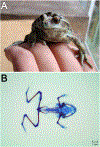Developmental Biology in Central America, the northern region of South America and the Caribbean
- PMID: 32930372
- PMCID: PMC9514024
- DOI: 10.1387/ijdb.200232jg
Developmental Biology in Central America, the northern region of South America and the Caribbean
Abstract
This review highlights the history of Developmental Biology studies in Latin-American countries of Central America, the northern region of South America and the Caribbean and their impact on the field. For this, we have compiled the contributions made by investigators in various institutions of the region, including universities, as well as agricultural, research and health centers. Most of the contributions focus on particular fields, among them, Evo-Devo, regenerative biology, nervous system development and health related issues. A large share of the contributions originates from a subset of countries, primarily, Colombia, Costa Rica, Ecuador, Panama and Puerto Rico. In addition, we underscore the new investigators and the ongoing research in the region.
Figures







Similar articles
-
Population and development in Latin America and the Caribbean.UFSI Rep. 1983;(7):1-11. UFSI Rep. 1983. PMID: 12279675
-
[Census probability of family extension: fertility levels and trends in Latin America].Notas Poblacion. 1987 Apr;15(43):9-24. Notas Poblacion. 1987. PMID: 12315179 Spanish.
-
Infant and child mortality in Latin America.Notas Poblacion. 1978 Apr;6(16):23-44. Notas Poblacion. 1978. PMID: 12335524 English, Spanish.
-
[Latin-American Dialysis and Kidney Transplantation Registry: data on the treatment of end-stage renal disease in Latin America].G Ital Nefrol. 2008 Sep-Oct;25(5):547-53. G Ital Nefrol. 2008. PMID: 18828117 Review. Italian.
-
Evolutionary Developmental Biology (Evo-Devo) Research in Latin America.J Exp Zool B Mol Dev Evol. 2017 Jan;328(1-2):5-40. doi: 10.1002/jez.b.22687. Epub 2016 Aug 5. J Exp Zool B Mol Dev Evol. 2017. PMID: 27491339 Review.
Cited by
-
Assessing biomedical research capacities in selected countries of Latin America: challenges, opportunities, and recommendations.Front Res Metr Anal. 2025 Jul 4;10:1594303. doi: 10.3389/frma.2025.1594303. eCollection 2025. Front Res Metr Anal. 2025. PMID: 40689359 Free PMC article.
References
-
- ALCOCER I, SANTACRUZ X, STEINBEISSER H, THIERAUCH K-H, DEL PINO EM (1992). Ureotelism as the prevailing mode of nitrogen excretion in larvae of the marsupial frog Gastrotheca riobambae (Fowler) (Anura, Hylidae). Comp Biochem Physiol 101A: 229–231. - PubMed
-
- ALMAGUER-MELIAN W, MERCERON-MARTINEZ D, DELGADO-OCANA S, PAVON-FUENTES N, LEDON N, BERGADO JA (2016). EPO induces changes in synaptic transmission and plasticity in the dentate gyrus of rats. Synapse 70:240–252. - PubMed
Publication types
MeSH terms
Grants and funding
LinkOut - more resources
Full Text Sources
Other Literature Sources

